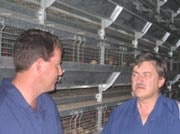An on-farm light trial at an egg farm in Young, NSW, will compare beak trimmed birds with non beak trimmed birds under commercial conditions.
Part of a Poultry CRC project looking at alternatives to beak trimming, the aim of the trial is to compare egg production, feather cover, injuries and mortality of 1000 non beak trimmed layers reared under low light with a similar group of layers in the same batch that have been beak trimmed using a infrared machine.
The trial is being implemented by the Project Leader, Phil Glatz, a Senior Research Scientist at SARDI’s Pig & Poultry Production Institute (PPPI), with help from Poultry CRC/AECL Extension Officer, Geof Runge.
“The participating farmer wants to determine if he needs to beak trim birds housed in low light conditions during both the rearing and the laying period,” said Geof.
“If successful, this may eliminate the need to beak trim laying stock reared in low light housing where lighting intensity can be controlled.”
“We know this works in environmentally controlled European systems,” said Phil, “but we need to establish if it works just as well under Australian conditions.”
The birds used in the trial will be hatched in mid June, assessed during the rearing period before being transferred to the laying shed around October, where they will remain, if all goes well, until January 2010. The final report for Project 07-17: Alternatives to beak trimming is expected to coincide with the end of the trial.
In other egg sector developments, a Commonwealth AgFund Free Range Management project instigated by AECL is underway on the Darling Downs to develop recommendations for improving best management practice for layer husbandry and stockmanship in the free range sector.
The University of Melbourne’s Dr Peter Scott will be conducting on farm evaluations with participating producers with the aim of improving farm performance. The project links in with an earlier Poultry CRC project which highlighted that free range farm performance could be improved through increased attention to husbandry and management practices on some farms.


